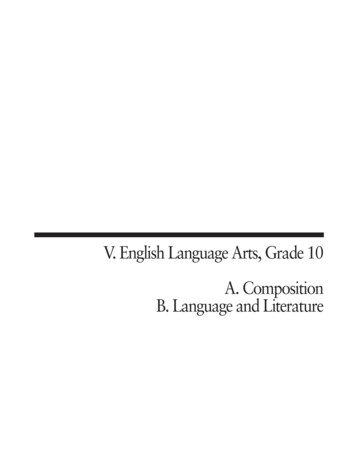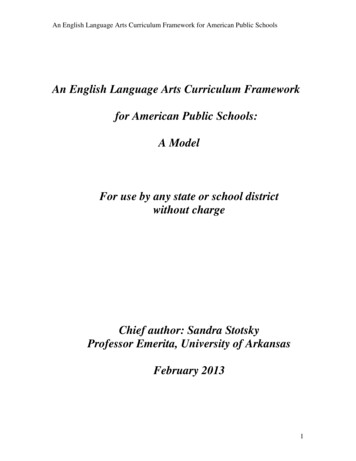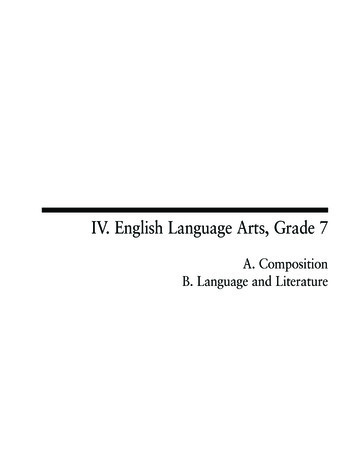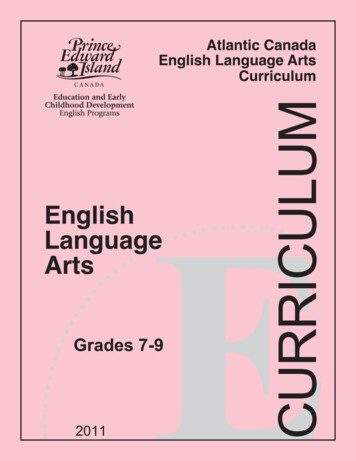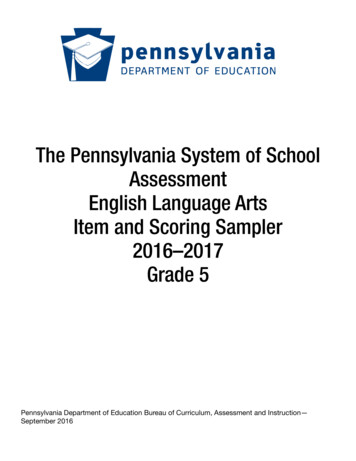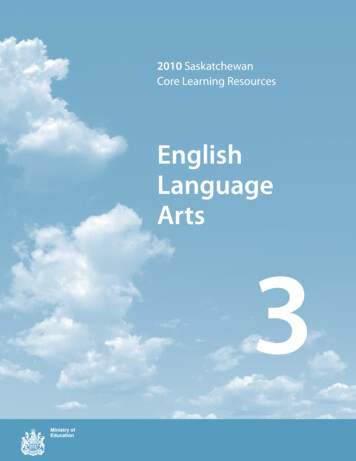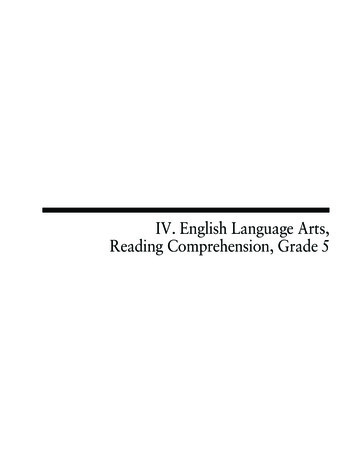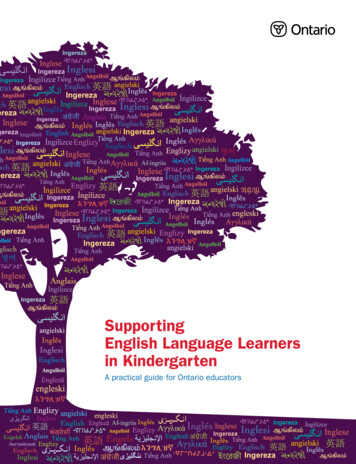
Transcription
English Language ArtsCurriculum FrameworkA Living DocumentSeptember 2020
English Language ArtsCurriculum FrameworkA Living DocumentSeptember 2020This framework is designed to be understood as aliving document. Because of the participatory natureof the development process, content continues to bevalidated, developed, and refined based on observationsand feedback from sustained deeper learning cohortsand groups, in collaboration with university facultyof education partners, and in consultation withother stakeholders.2020Manitoba Education
English language arts curriculum framework : a living documentIncludes bibliographical references.Copyright 2020, the Government of Manitoba, represented by the Ministerof Education.Manitoba EducationWinnipeg, Manitoba, CanadaEvery effort has been made to acknowledge original sources and to complywith copyright law. If cases are identified where this has not been done, pleasenotify Manitoba Education. Errors or omissions will be corrected in a futureedition. Sincere thanks to the authors, artists, and publishers who allowedtheir original material to be used.All images found in this resource are copyright protected and should notbe extracted, accessed, or reproduced for any purpose other than for theirintended educational use in this resource.Any websites referenced in this resource are subject to change without notice.Educators are advised to preview and evaluate websites and online resourcesbefore recommending them for student use.This resource is available on the Manitoba Education website atwww.edu.gov.mb.ca/k12/.Websites are subject to change without notice.While the department is committed to making its publications as accessible aspossible, some parts of this document are not fully accessible at this time.Available in alternate formats upon request.
ground1Foundations and Principles5What Is English Language Arts?5Relationship between English Language Arts and Literacy5Guiding Principles6Powerful Practice in English Language Arts18The English Language Arts Learning Landscape21English Language Arts Goals21What Grounds the Design of the ELA Curriculum?22The English Language Arts Conceptual Framework22Competency, Communities, and Meaningful Contexts23Effective English Language Arts Planning, Teaching, and Learning27Assessment As, For, and Of Learning34English Language Arts Practices37What is the Structure of the ELA Curriculum?44Structural Design of the English Language Arts Curriculum45Planning Effectively for English Language Arts47Planning for Rich, Meaningful Learning Experiences and Deeper Understanding47Using Lenses to Plan Rich, Meaningful Learning Experiences49Using Lenses to Focus and Deepen Learning Experiences51Approaches to Instructional Design53Embedding and Connecting Programmatic Structures in Rich Learning Experiences54Grade Bands, Learning Growth, and Dimensions of Learning57Enacting the Practices and Dimensions of Learning Growth: Independence,Breadth, Depth, and Transformation57Interrelated Dimensions of Learning Growth59Contentsiii
Grade Band DescriptorsEnacting the Four ELA Practices in the K to 2 Grade Band66Enacting the Four ELA Practices in the 3 to 5 Grade Band67Enacting the Four ELA Practices in the 6 to 8 Grade Band68Appendix: Elaborations69Language as Sense Making: Kindergarten to Grade 269Language as System: Kindergarten to Grade 272Language as Exploration and Design: Kindergarten to Grade 274Language as Power and Agency: Kindergarten to Grade 276Language as Sense Making: Grades 3 to 579Language as System: Grades 3 to 581Language as Exploration and Design: Grades 3 to 584Language as Power and Agency: Grades 3 to 586Language as Sense Making: Grades 6 to 888Language as System: Grades 6 to 891Language as Exploration and Design: Grades 6 to 893Language as Power and Agency: Grades 6 to 895Referencesiv65English Language Arts Curriculum Framework: A Living Document99
AcknowledgementsManitoba Education gratefully acknowledges the contributions of the following individualsand groups in the development of the English Language Arts Curriculum Framework: A LivingDocument.Because of the participatory nature of the development process, content continues to be tested,revised, and developed based on observations and feedback from sustained deeper learningcohorts, in collaboration with education faculty members, and in consultation with otherstakeholders.Development and Implementation Co-leadersAngela Burdett (from September 2017)Karen Boyd (until August 2014)Lisa Goolcharan (from January 2019)Shelley Warkentin (until January 2019)Critical Friends, Contributors, ReviewersKaren Boyd (from September 2014)Michelle HoneyfordMarlene McKayWayne SerebrinShelley Warkentin (from January 2019)River East Transcona School DivisionUniversity of ManitobaIndependent ConsultantUniversity of ManitobaSeven Oaks School DivisionInitial Working GroupBrandi BartokJonine BergenAngela BurdettSusan HaywardJessica KowallSteve LawrieElaine LevesqueSara MacPhersonRuth McDonaldVirginia MooseGeorgette NairnCathy OresnikJodianna PatersonMark ReimerWayne SerebrinChris WigglesworthKaren WiebePembina Trails School DivisionSt. Paul’s High SchoolFrontier School DivisionLakeshore School Division (until 2015) andIndependent (from 2015)Child Guidance Clinic, Winnipeg School Division(until 2015)Louis Riel School Division (until 2015)Division scolaire franco-manitobaineManitoba Education and TrainingPembina Trails School DivisionMystery Lake School DivisionRiver East Transcona School DivisionPembina Trails School DivisionChild Guidance Clinic, Winnipeg School Division(from 2015)Hanover School DivisionUniversity of ManitobaSeven Oaks School DivisionManitoba Teachers’ SocietyInitial Grade Band Exploration GroupJen AndersonElizabeth BourbonniereAngela BurdettMike ChopekBrandon School DivisionRiver East Transcona School DivisionFrontier School DivisionFrontier School DivisionAcknowledgementsv
Cathy-Jane GreenMichelle HoneyfordHeather KhanJennifer KolesarClaudette LaurieElaine LevesqueRuth McDonaldJanice MatthewmanRenee McGurryJennifer McKinnonGeorgette NairnMark ReimerMonica ReisMichelle VermetteChris WigglesworthAndrea ZarodaBrandon School DivisionUniversity of ManitobaSt. James-Assiniboia School DivisionPrairie Spirit School DivisionBureau de l’éducation françaiseDivision scolaire franco-manitobainePembina Trails School DivisionSt. James-Assiniboia School DivisionSt. James-Assiniboia School DivisionLouis Riel School DivisionRiver East Transcona School DivisionHanover School DivisionRolling River School DivisionSeven Oaks School DivisionSeven Oaks School DivisionRiver East Transcona School DivisionPilot Cohort (June 2015 to June 2017)Frontier School DivisionMountain View School DivisionRiver East Transcona School DivisionSt. James-Assiniboia School DivisionSeine River School Division (until June 2016)Targeted Development TeamJoan BadgerKelsey BlackAngela BurdettStacey CookSuzanne CottynWendy GautierStacey HasselCharlene HelgesonKelly MayTara McLaughlinDarlene Michalot-DumasLouisa PetznickNicole StaniforthAndrea ZarodaSt. James-Assiniboia School DivisionMountain View School DivisionFrontier School DivisionMountain View School DivisionMountain View School DivisionFrontier School DivisionMountain View School DivisionMountain View School DivisionRiver East Transcona School DivisionSt. James-Assiniboia School DivisionFrontier School DivisionFrontier School DivisionSeine River School DivisionRiver East Transcona School DivisionSustained Deeper Learning Cohorts (June 2017 to April 2019):South Central CohortBorder Land School DivisionGarden Valley School DivisionPine Creek School DivisionPortage la Prairie School DivisionPrairie Rose School DivisionPrairie Spirit School DivisionRed River Valley School DivisionWestern School DivisionviEnglish Language Arts Curriculum Framework: A Living Document
Provincial CohortHanover School DivisionMystery Lake School DivisionPark West School DivisionPembina Trails School DivisionWinnipeg School Division (until June 2019)Northwest CohortFlin Flon School DivisionKelsey School DivisionSwan Valley School DivisionSeven Oaks School Division CohortSouthwest CohortFort la Bosse School DivisionRolling River School DivisionSouthwest Horizon School DivisionTurtle Mountain School DivisionTurtle River School DivisionWinnipeg School Division CohortManitoba Education StaffCarole BilykCoordinator (until August 2016)Development UnitInstruction, Curriculum and Assessment BranchLouise BoissonneaultCoordinatorDocument Production Services UnitInclusion Support BranchKaren BoydProject Co-leader/Consultant(until August 2014)Development UnitInstruction, Curriculum and Assessment BranchAngela BurdettProject Co-leader/Consultant(from September 2017)Early Childhood and Development UnitInstruction, Curriculum and Assessment BranchWenda DickensCoordinator (until April 2018)Early Childhood and Development UnitInstruction, Curriculum and Assessment BranchDarryl GervaisDirector (until February 2019)Instruction, Curriculum and Assessment BranchLisa GoolcharanProject Co-leader/Consultant(from January 2019)Early Childhood and Development UnitInstruction, Curriculum and Assessment BranchKristin GrapentineDesktop PublisherDocument Production Services UnitInclusion Support BranchVictoria McMahonProject Co-leader/Consultant(September 2019)Early Childhood and Development UnitInstruction, Curriculum and Assessment BranchAcknowledgementsvii
viiiMarjorie PoorPublications EditorDocument Production Services UnitInclusion Support BranchDiana TurnerActing Coordinator (from April 2018)Early Childhood and Development UnitInstruction, Curriculum and Assessment BranchShelley WarkentinProject Co-leader/Consultant(until January 2019)Early Childhood and Development UnitInstruction, Curriculum and Assessment BranchEnglish Language Arts Curriculum Framework: A Living Document
IntroductionPurposeThe purposes of English Language Arts Curriculum Framework: A Living Documentare to support, nurture, and inspire the learning growth of all learners provide direction for learning design and assessment set out the philosophical and pedagogical foundations for English languagearts learning present the four English language arts practices and their characterizingelements describe multiple ways that students engage in practices at various points inlearning encourage educators and learners “to engage in vital, rigorous, andventurous forms of pedagogy” (Jardine and Friesen 4)BackgroundIn January 2011, the Western and Northern Canadian Protocol forCollaboration in Education, Kindergarten to Grade 12 (WNCP) preparedGuiding Principles for WNCP Curriculum Framework Projects in response to thesignificant changes in the ways people live and work in today’s world.In July 2011, the report Implications of the OECD’s Programme for InternationalStudent Assessment (PISA) for Curriculum, Instruction, and Professional Learningin Manitoba (and Canada) (Manitoba Education) was developed for Manitoba toprovide an analysis of English language arts (ELA) curriculum, approaches toprofessional learning, and assessment practices across Canada.In January 2012, Manitoba engaged focus groups of Manitoba educators inorder to hear observations, insights, and feedback related to ELA curriculum,supports, resources, and assessment.A report for WNCP partners was published in March 2012: English LanguageArts in Canada and around the World: Renewal of the WNCP Framework andAssociated Curricula Based upon Guiding Principles for WNCP CurriculumFramework Projects) (Western and Northern Canadian Protocol forCollaboration).In January 2013, Jardine and Friesen developed a follow-up document,Implementation Guide: Guiding Principles for WNCP Curriculum FrameworkProjects.Introduction1
The English language arts curriculum framework responds to multiple reportsand reflects the WNCP guiding principles that aim to meet the current andfuture needs of learners as well as the needs of societies. This framework alsoresponds to current research and literature in curriculum, English languagearts, and pedagogies.Shifts in curriculum design and growing knowledge related to changingeducator practice require shifts in implementation models. Current processesmust represent networked, connected, and emergent processes that engageeducators deeply and in sustained ways in conversation, reflection, and action.Implementation no longer means simply imposing already fully understoodprinciples to specific examples. This is the old industrial model of applicationand is no longer warrantable in the 21st century. Rather, it means allowingspecific examples, locales, communities of work and cultural realities toquestion, shape, and supplement (Gadamer 1989, p. 39) those principles andto make them “fitting” for the circumstances of their application. (Jardine andFriesen 5)Further Reading, Viewing, and ResearchCurriculum DesignAoki, Ted T. Curriculum in a New Key: The Collected Words of Ted T. Aoki. Edited byWilliam F. Pinar and Rita L. Irwin, Lawrence Erlbaum, 2004.British Columbia. BC’s New Curriculum: English Language Arts. nguage-arts. Accessed 3 Oct. 2018.Clandinin, D. Jean, and F. Michael Connelly. “Teacher as Curriculum Maker.” Handbookof Research on Curriculum: A Project of the American Educational ResearchAssociation, edited by Philip W. Jackson, Macmillan, 1992, pp. 363–461.Claypool, Tim R., and Jane P. Preston. “Redefining Learning and Assessment PracticesImpacting Aboriginal Students: Considering Aboriginal Priorities via Aboriginaland Western Worldviews.” In Education, vol. 17, no. 3, 2011, pp. 84–95, /561. Accessed 19 Oct. 2018.Craig, Cheryl J., JeongAe You, and Suhak Oh. “Pedagogy through the Pearl Metaphor:Teaching as a Process of Ongoing Refinement.” Journal of Curriculum Studies, vol. 49,no. 6, 2017, pp. 757–781.Davis, Brent, and Dennis Sumara. Complexity and Education: Inquiries into Learning,Teaching and Research. Lawrence Erlbaum, 2006.Doll, William E., Jr. “Curriculum Possibilities in a ‘Post’-Future.” Journal ofCurriculum and Supervision, vol. 8, no. 4, Summer 1993, pp. /Curriculum Possibilitiesin a %E2%80%9CPost%E2%80%9D-Future.aspx. Accessed 19 October 2018.Doll, William E. “Complexity and the Culture of Curriculum.” Educational Philosophyand Theory, vol. 40, no. 1, Feb. 2008, pp. 190–212.Donald, Dwayne Trevor. “Forts, Curriculum, and Indigenous Métissage: ImaginingDecolonization of Aboriginal-Canadian Relations in Educational Contexts.” FirstNations Perspectives, vol. 2, no. 1, 2009, pp. 1–24, www.mfnerc.org/wp-content/uploads/2012/11/004 Donald.pdf. Accessed 18 Oct. 2018.Fass, John. “Adaptation and Input: Defining a Living Curriculum.” ACM CHIConference on Human Factors in Computing Systems. CHI 2014, 26 April–1 May2014, Metro Toronto Convention Centre. Available online at https://sigchi.org/wpcontent/uploads/2017/01/W30 Fass.pdf. Accessed 29 July 2019.2English Language Arts Curriculum Framework: A Living Document
Grotzer, Tina, David Vaughn, and Bill Wilmot. “The Seven Principles of LivingCurriculum.” Independent School, Spring 2019, um/.Accessed 29 July 2019.Honeyford, Michelle A., and Jennifer Watt. “Burrowing and Becoming: TeachingWriting in Uncertain Times.” Pedagogies: An International Journal, vol. 13, no. 3,Nov. 2018, pp. 260–279.Jardine, David W., Patricia Clifford, and Sharon Friesen. Curriculum in Abundance.Lawrence Erlbaum, 2006.Jardine, David, and Sharon Friesen. Implementation Guide: Guiding Principles forWNCP Curriculum Framework Projects. 2013.Kalantzis, Mary, and Bill Cope. New Learning: Elements of a Science Education.2nd ed., Cambridge University Press, 2012.Kalantzis, Mary, and Bill Cope. “The Teacher as Designer: Pedagogy in the New MediaAge.” E-Learning and Digital Media, vol. 7, no. 3, 2010, pp. 200–222.Kanu, Yatta, editor. Curriculum as Cultural Practice: Postcolonial Imaginations.University of Toronto Press, 2006.Kozleski, Elizabeth B., and Federico R. Waitoller. “Teacher Learning for InclusiveEducation: Understanding Teaching as a Cultural and Political Practice.” InternationalJournal of Inclusive Education, vol. 14, no. 7, Nov. 2010, pp. 655–666.Kress, Gunther. “A Curriculum for the Future.” Cambridge Journal of Education,vol. 30, no. 1, 2000, pp. 133–145.The Learning Exchange. “Marlene Scardamalia—Students as Curriculum Designers:Deep Constructivism.” Knowledge Building—Knowledge Builders, tivism/?pcat &psess &ptit Knowledge Building–KnowledgeBuilders&ps knowledge-building-knowledge-builders. Accessed 4 Oct. 2018.Manitoba Education. Kindergarten to Grade 8 Visual Arts: Manitoba CurriculumFramework of Outcomes. Manitoba Education, 2011.Manitoba Education and Advanced Learning. Grades 9 to 12 Visual Arts: ManitobaCurriculum Framework. Manitoba Education and Advanced Learning, 2015, https://www.edu.gov.mb.ca/k12/cur/arts/docs/visual 9-12.pdf. Accessed 18 Oct. 2018.Manitoba Education and Training. Grades 5 to 8 English Language Arts: A Foundationfor Implementation. Manitoba Education and Training, 1998.Manitoba Education and Training. Grades 5 to 8 English Language Arts: ManitobaCurriculum Framework of Outcomes and Grade 6 Standards. Manitoba Education andTraining, 1996.Manitoba Education and Training. Kindergarten to Grade 4 English Language Arts: AFoundation for Implementation. Manitoba Education and Training, 1998.Manitoba Education and Training. Kindergarten to Grade 4 English Language Arts:Manitoba Curriculum Framework of Outcomes and Grade 3 Standards. ManitobaEducation and Training, 1996.Mezirow, Jack, and Associates. Learning as Transformation: Critical Perspectives on aTheory in Progress. Jossey-Bass, 2000.Munroe, Elizabeth Ann, Lisa Lunney-Borden, Anne Murray-Orr, Denise Toney, andJane Meader. “Decolonizing Aboriginal Education in the 21st Century.” McGill Journalof Education, vol. 48, no. 2, 2013, pp. 317–337.New Zealand Ministry of Education. The New Zealand Curriculum. riculum. Accessed 5 Oct. 2018.New Zealand Ministry of Education. Teaching as Inquiry in the New ZealandCurriculum. eaching-as-inquiry-inthe-NZC. Accessed 4 Oct. 2018.Osberg, Deborah, and Gert Biesta. “The End/s of Education: Complexity and theConundrum of the Inclusive Educational Curriculum.” International Journal ofInclusive Education, vol. 14, no. 6, 2010, pp. 593–607.Introduction3
Pratt, Sarah Smitherman. “Complex Constructivism: Rethinking the Power Dynamicsof ‘Understanding’.” Journal of Canadian Association for Curriculum Studies, vol. 6,no. 1, Spring/Summer 2008, pp. 113–132.Priestley, Mark, and Gert Biesta, editors. Reinventing the Curriculum: New Trends inCurriculum Policy and Practice. Bloomsbury, 2013.Sagal, Jane Thurgood. Shifting Horizons of Understanding: How Teachers InterpretCurriculum in Their Practice. VDM Verlag, 2009.Saskatchewan Ministry of Education. Saskatchewan Curriculum: Education: TheFuture within Us. BBLEARN/index.jsp. Accessed 9 Oct. 2018.Schon, Donald A. The Reflective Practitioner: How Professionals Think in Action. BasicBooks, 1983.Schwartz, Marc S., Philip M. Sadler, Gerhard Sonnert, and Robert H. Tai. “DepthVersus Breadth: How Content Coverage in High School Science Courses Relates toLater Success in College Science Coursework.” Science Education, vol. 93, no. 5,Sept. 2009, pp. 798–826, doi:https://doi.org/10.1002/sce.20328.Stray, Janicke Heldal, and Emil Sætra. “Teaching for Democracy: TransformativeLearning Theory Mediating Policy and Practice.” Nordic Journal of Pedagogy andCritique, vol. 3, no. 1, Dec. 2017, pp. 1–16, doi:https://doi.org/10.23865/ntpk.v3.555.Western and Northern Canadian Protocol for Collaboration (WNCP). Guiding Principlesfor WNCP Curriculum Framework Projects. Jan. 2011.4English Language Arts Curriculum Framework: A Living Document
Foundations and PrinciplesWhat Is English Language Arts?Relationship between English Language Arts and LiteracyIn all school subjects and in all facets of life, students are engaged in literatebehaviours. Current understandings of literacy suggest that learnersparticipate in multiple literacy communities and that each community hasparticular ways of thinking, doing, and using and creating text. Learners needto be flexible in their literacy learning in order to be active participants in avariety of communities both in school and in other places in their life. In alldisciplines or fields of study, students should be engaged in literacy learningspecific to each discipline. In science, for example, students learn about thetexts that are authentic to that discipline and the particular ways of thinkingabout those texts. Reading for historical accuracy requires different processesthan reading scientific data in order to make a judgment. Similarly, ELA hasparticular texts and particular ways of considering language and the world.English language arts recognizes that the particular discipline of ELA has bothits own way of thinking and the responsibility to support the literacy learningthat transfers through and between other disciplines. Literacy practices fromall fields as well as those that are particular to ELA offer multiple ways forlearners to engage with, connect with, and respond to their world.In the ELA curriculum, the word texts refers to the variety of resourcesthat we use to make meaning. These include aural/oral, visual, print,digital, physical, gestural, and spatial texts, and the various combinationsof these. For example, a news video could have gestural, oral, visual, andprint components simultaneously. Many different objects are imbued withmeaning and used for different purposes depending on how people createor attend to them.Language and literacies are symbolic socio-cultural systems throughwhich human beings create and share meanings. They do so by using theconventional meaning-making and meaning-sharing practices within theirsocio-cultural groups, while at the same time inventing new ones.Foundations and Principles5
Guiding PrinciplesHow English language arts is represented in curriculum and enacted inclassrooms is anchored by guiding principles. Educators are called upon tointerpret and live out curriculum through these principles and reflect onimplications for their planning.Language and literacies are central to all learning.Language and literacies are tools for making meaning across any learningcontext—in and out of school. An ability to work across languages andliteracies opens paths to social participation and learning. Today’s learnersneed a broad communicative repertoire in order to interact with and navigatemultiple forms of text and social contexts. This repertoire provides multipleways to participate. Language particular to academic fields (e.g., the wayswe make and communicate meaning in science) and fields and experiencesbeyond school (e.g., ways we make and communicate meaning within socialgroups and communities) helps us to participate more deeply. Understandingand using the particular language, ways of thinking, and the social norms andpractices within particular contexts helps us to actively participate and engagemore deeply.Reflection: How do I design learning experiences so that learners have meaningfulopportunities to use language and literacies in all facets of learning? How do I model and help surface the multiple ways that we use languageand literacies in learning and life? How do I support learners as they notice, name, and strategically makedecisions about the language and literacies they use within and acrosscontexts?Further Reading, Viewing, and ResearchBrownlie, Faye, and Leyton Schnellert. It’s All about Thinking: Collaborating toSupport All Learners in English, Social Studies, and Humanities. Portage & MainPress, 2009.Halliday, M. A. K. “Towards a Language-Based Theory of Learning.” Linguistics andEducation, vol. 5, no. 2, 1993, pp. 93–116.Hicks, Deborah. “Discourse, Learning and Teaching.” Review of Research inEducation, vol. 21, 1995, pages 49–95.Jetton, Tamara L., and Cynthia Shanahan, editors. Adolescent Literacy in theAcademic Disciplines: General Principles and Practical Strategies. Guilford Press,2012.Mills, Heidi. Learning for Real: Teaching Content and Literacy across the Curriculum.Heinemann, 2014.Mills, Heidi, Tim O’Keefe, Chris Hass, and Scott Johnson. “Changing Hearts, Minds,and Actions through Collaborative Inquiry.” Language Arts, vol. 92, no. 1, Sept. 2014,pp. 36–51.6English Language Arts Curriculum Framework: A Living Document
Moje, Elizabeth Birr. “Developing Socially Just Subject-Matter Instruction: A Reviewof the Literature on Disciplinary Literacy Teaching.” Review of Research in Education,vol. 31, no. 1, 2007, pp. 1–44.Moje, Elizabeth Birr, Kathryn McIntosh Ciechanowski, Katherine Kramer, Lindsay Ellis,Rosario Carrillo, and Tehani Collazo. “Working toward Third Space in Content AreaLiteracy: An Examination of Everyday Funds of Knowledge and Discourse.” ReadingResearch Quarterly, vol. 39, no. 1, Jan.–Mar. 2004, pp. 38–70.Schoenbach, Ruth, Cynthia Greenleaf, and Lynn Murphy. Reading for Understanding:How Reading Apprenticeship Improves Disciplinary Learning in Secondary andCollege Classrooms. 2nd ed., Jossey-Bass, 2012.Shanahan, Timothy, and Cynthia Shanahan. (2008). “Teaching Disciplinary Literacy toAdolescents: Rethinking Content-Area Literacy.” Harvard Educational Review, vol. 78,no. 1, Spring 2008, pp. 40–59.Language and literacies are context dependent.Language differences are important. Multiple ways of knowing and seeingthe world, multiple modes for making and communicating meaning, multiplevariations of languages and dialects are critical to an evolving and equitablesociety.There is a lot of divergence in the social languages we use. How we uselanguage will shift as we navigate different contexts. For example, ourpractices will potentially be different in the context of a community feastcompared to those on social media. How language and literacies are situatedin contexts makes them valid and meaningful. Navigating cultural context,purposes, and audiences is therefore critical. This requires users to bediscerning and thoughtful decision makers. When language and literaciesare understood as situated, it is also understood that conventions will differas well.Reflection: How do I make space in learning environments to honour and celebratethe multiple ways that learners and communities make and communicatemeaning? How do I harness knowledge, experiences, cultures, and languages oflearners and their families to support and deepen the learning of all? How do I recognize and help others to recognize that the ways we uselanguage and literacies will change based on context? How do I support learners in becoming discerning decision makers inrelation to language and literacies?Foundations and Principles7
Further Reading, Viewing, and ResearchBarton, David, Mary Hamilton, and Roz Ivanič, editors. Situated Literacies: Readingand Writing in Context. Routledge, 2000.Botelho, Maria José. “Naming Practices: Defining Critical Multicultural Literacies.”Orbit, vol. 36, no. 3, 2007, pp. 27–30.Brandt, Deborah, and Katie Clinton. “Limits of the Local: Expanding Perspectives onLiteracy as a Social Practice.” Journal of Literacy Research, vol. 34, no. 3, 2002, pp.337–356.Cardinal, Trudy. “Mosoms and Moccasins . . . Literacy in an Indigenous Context.”Canadian Social Studies, vol. 48, no. 1, 2015, pp. 1–7.Gee, James Paul. “The New Literacy Studies and the ‘Social Turn.’ ” 1999.Opinion paper.Gee, James Paul. “Reading as Situated Language: A Sociocognitive Perspective.”Journal of Adolescent and Adult Literacy, vol. 44, no. 8, May 2001, pp. 714–725.Gee, James Paul. Situated Language and Learning: A Critique of Traditional Schooling.Routledge, 2004.Gee, James Paul. Social Linguistics and Literacies: Ideology in Discourses. 3rd ed.,Routledge, 2008.Gutiérrez, Kris D., and Lynda D. Stone. “Synchronic and Diachronic Dimensions ofSocial Practice: An Emerging Methodology for Cultural-Historical Perspectives onLiteracy Learning.” Vygotskian Perspectives on Literacy Research: ConstructingMeaning through Collaborative Inquiry, edited by Carol D. Lee and PeterSmagorinsky, Cambridge University Press, 2000, pp. 150–164.Honeyford, Michelle A. “Writing as Teachers: The Power of Place.” Language Arts,vol. 94, no. 4, Mar. 2017, pp. 279–281.Kalantzis, Mary, Bill Cope, Eveline Chan, and Leanne Dalley-Trim. Literacies.2nd ed., Cambridge University Press, 2016. Supporting materials available athttp://newlearningonline.com/literacies.Llopart, Mariona, and Moisès Esteban-Guitart. “Funds of Knowledge in 21st CenturySocieties: Inclusive Educational Practices for Under-Represented Students. ALiterature Review.” Journal of Curriculum Studies, vol. 50, no. 2, 2018, pp. 145–161.Moje, Elizabeth Birr, and Kathleen Hinchman. “Culturally Responsive Practices forYouth Literacy Learning.” Adolescent Literacy Research and Practice, edited byTamara L. Jetton and Janice A. Dole, Guilford Press, 2004, pp. 321–350.Language and literacy learning is complex, continuous,and recursive.Language and literacies are not something that one either has or does nothave. Rather, language and literacies are multiple, dynamic, and malleable.Language and literacies are mobilized in multiple ways and in variouscontexts. Authentic language and literacy experiences engage learners inpractice—drawing upon multiple skills, knowledge, strategies, processes, andresources all at once. Language and literacy learning is o
Chris Wigglesworth Seven Oaks School Division Andrea Zaroda River East Transcona School Division Pilot Cohort (June 2015 to June 2017) Frontier School Division Mountain View School Division River East Transcona School Division St. James-Assiniboia School Division Seine River School Division (until June 2016) Targeted Development Team

